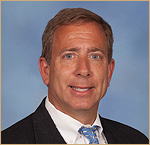The markets interpreted FRB Chair Powell’s market as “decisively dovish,” all but cementing an interest rate reduction at the September meeting.
The S & P 500 halted a five-day decline, rising about 1.5%, two-year Treasury yields, which are more sensitive to imminent policy moves, sank about 10 bps, and Fed Fund futures are now suggesting a 90% chance of a reduction in September, up from about 65% before Powell spoke.
Powell’s comment “the stability of the unemployment rate and other labor market measures allows us to proceed carefully as we consider changes to our policy stance…nonetheless, with policy in restrictive territory, the baseline outlook and the shifting balance of risks may warrant adjusting our policy stance.
By shifting focus toward risks in the job market, the Fed Chair signaled it may not wait for perfect inflation to lower rates.
His remarks offered the reassurance the markets had been waiting for.
Radically changing topics, value has been outperforming growth for the last 7-10 trading days. Is this just noise as has been the case since the Great Financial Crisis? Several high-profile growth managers have made comments similar to Mark Twain’s infamous quote “Has the death of value been greatly exaggerated.”
The concentration of funds in growth stocks is highly documented. Several weeks ago approximately 39% of the S & P 500 was comprised of the Magnificent Seven, companies that have an average forward-looking price to earnings ratio of roughly 28 versus 22 for the S & P 500. Value’s PE ratio is just under 15.
Moreover, according to Reuters, as passive ETFs continue to grow, nearly 60% of the US stock market is now held in passive funds, passive funds that favor the largest capitalized companies by definition.
As widely stated, the markets can remain irrational one day longer than one can remain sane or solvent. Dramatic change occurs when almost all believe that it will not.
What will happen this week?
The economic calendar is comprised of several housing statistics, manufacturing surveys, revised 2Q GDP and the ancillary inflation data, a sentiment survey, personal spending/income and monthly PCE data.
Last night the foreign markets were mixed. London was up 0.13%, Paris down 0.66% and Frankfurt down 0.20% . China was up 1.51%, Japan up 0.41% and Hang Seng up 1.94%.
Futures are nominally lower as some of the post Jackson Hole euphoria is subsiding. At the time of this writing the market is suggesting an 84% chance of an interest rate reduction in September. And then there is INTC. Is this partial nationalization of a private company? What are the unintended consequences of the President’s plans to take a 10% stake in the company? Will this action—largely unprecedented but has mainly occurred only in times of crisis– be riddled with unquantifiable outcomes?
And then there is NVDA whose results are reported Wednesday after the close. This $4.3 trillion behemoth comprises an incredible 8% of the S & P 500 capitalization, making it a crucial stock for all ETF owners across the world and an essential company chasing the AI mania. NVDA is worth as almost as much as the Paris and London market combined. It is up about 105% from its mid-April low.
The 10-year is off 7/32 to yield 4.29%.




